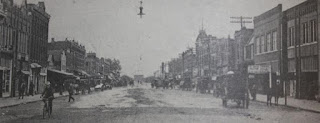He may be the same Charles F. Brown who was born and
raised in Texas in the 1940s and ‘50s, and who became a songwriter even while
serving his country in the U.S. Navy in the following decade. He’s lauded by
some of his peers, who apparently inducted him into the Texas Gospel Music Hall
of Fame. So what made him write (perhaps while in his native Texas) about “A Common
Love” he shared with all these people is rather un-mysterious in some respect,
as he’d grown up with a background and education that paved the way for his
songwriting. But, did having served his
country during a difficult period (the late 1960s) also give him some explicit
emotions that he thought were relevant for his time, as he reflected on the
state of his surroundings in 1974? Perhaps someone out there should quiz
Charles to hear what he says. …anyone?
Charles F. Brown’s upbringing must have played a
significant role for what later, by the mid-1960s, would further shape his
outlook and spawn “A Common Love” even later when he was 32 years old. In other
words, let’s just assume it was a lengthy process that brought him to the year 1974,
when he decided to say something about what was common in his Christian faith. Since
his Nixon, Texas years where he was no doubt influenced by his family, including
his Baptist preacher father, Charles evidently wanted to make music his career.
Music degrees from Baylor and Southern Methodist University were precursors to
a four-year stint in the Navy as a teacher in its School of Music in Virginia
in the 1966-70 era. Like the composer who wrote about being bound together in
the same year (Bob Gillman, see blog entry for 23 July 2016), Brown was approximately
the same age and was part of an unpopular, divisive war’s generation. As a
believer, perhaps he was also aware of the Jesus Movement and their principles –
to focus on the love of Jesus and the unity He brings in communes rather than
churches – although it’s not clear that Brown participated in this. Could his
words have been intended to reach out to all believers, however, including the
Jesus “freaks” in communes? What better way was there to do so, than to spell
out poetically-musically what six things all Jesus believers have in common
with one another? It was spiritual glue that Charles sought to apply, with a
musical brush, to his environment, perhaps as a curative measure for what ailed
that time’s inhabitants.
What common components of belief did Charles Brown
see? Perhaps he thought they all looped back to the song title’s bonding element
– love. ‘Make love, not war’, the time’s so-called counterculture said in the
late ‘60s-early ‘70s. There were many who scoffed at the hippies who liberally
employed the phrase’s meaning, doubting its utopian ideals as well as its indulgence
in the immoral. So, did this 30-something Brown offer his “…Common Love” as his
own answer for the freaks, as well as for others outside of that generation?
Just who can turn down love’s parts -- a ‘gift’, ‘bond’, and ‘strength’, and ‘hope’
or ‘joy’?
More input, as of May 2017! (via someone at Incline Media...thanks for the input! See this also in the blog comment at the bottom)-- The Charles F. Brown you're talking about here is one of my best friends and a musical mentor to me for many years, and here's the real inspiration behind this song:
Charlie was in charge of publishing for Word Records when it was in Waco TX, and in the early 70s he was working on what would become an industry-disrupting idea of his own - a collection of new music called Sing N Celebrate. As he was working on the layout of the book, there were several blank single pages throughout the book because of the way it was all coming together. And since he didn't want any blank pages, he wrote several songs expressly for the purpose of filling those blank pages in the book, one of which was "Common Love." Another one you might recognize was called "Part the Waters," one of Charlie's best-loved songs.
Charlie would say that inspiration comes in many forms, but often it's in the form of a deadline!
More input, as of May 2017! (via someone at Incline Media...thanks for the input! See this also in the blog comment at the bottom)-- The Charles F. Brown you're talking about here is one of my best friends and a musical mentor to me for many years, and here's the real inspiration behind this song:
Charlie was in charge of publishing for Word Records when it was in Waco TX, and in the early 70s he was working on what would become an industry-disrupting idea of his own - a collection of new music called Sing N Celebrate. As he was working on the layout of the book, there were several blank single pages throughout the book because of the way it was all coming together. And since he didn't want any blank pages, he wrote several songs expressly for the purpose of filling those blank pages in the book, one of which was "Common Love." Another one you might recognize was called "Part the Waters," one of Charlie's best-loved songs.
Charlie would say that inspiration comes in many forms, but often it's in the form of a deadline!
This link shows the composer’s birth year: http://www.hymnary.org/person/Brown_CF
This link-site may refer to the same person, and
provides some biography on the composer: http://www.tgmhf.org/charles-f-brown/
Link to the Jesus Movement of that period: https://en.wikipedia.org/wiki/Jesus_movement





